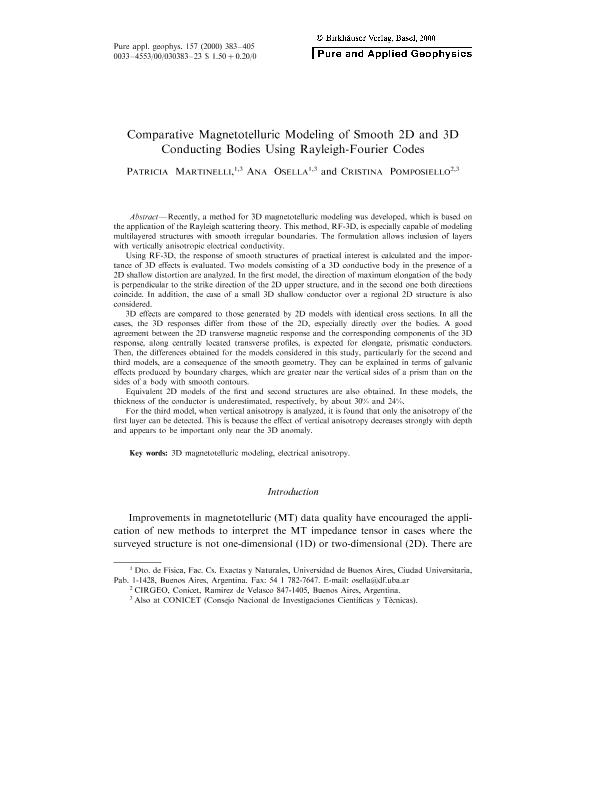Mostrar el registro sencillo del ítem
dc.contributor.author
Martinelli, Hilda Patricia

dc.contributor.author
Osella, Ana
dc.contributor.author
Pomposiello, Maria Cristina

dc.date.available
2018-08-07T15:21:26Z
dc.date.issued
2000-12
dc.identifier.citation
Martinelli, Hilda Patricia; Osella, Ana; Pomposiello, Maria Cristina; Comparative magnetotelluric modeling of smooth 2D and 3D conducting bodies using Rayleigh-Fourier codes; Birkhauser Verlag Ag; Pure And Applied Geophysics; 157; 3; 12-2000; 383-405
dc.identifier.issn
0033-4553
dc.identifier.uri
http://hdl.handle.net/11336/54419
dc.description.abstract
Recently, a method for 3D magnetotelluric modeling was developed, which is based on the application of the Rayleigh scattering theory. This method, RF-3D, is especially capable of modeling multilayered structures with smooth irregular boundaries. The formulation allows inclusion of layers with vertically anisotropic electrical conductivity. Using RF-3D, the response of smooth structures of practical interest is calculated and the importance of 3D effects is evaluated. Two models consisting of a 3D conductive body in the presence of a 2D shallow distortion are analyzed. In the first model, the direction of maximum elongation of the body is perpendicular to the strike direction of the 2D upper structure, and in the second one both directions coincide. In addition, the case of a small 3D shallow conductor over a regional 2D structure is also considered. 3D effects are compared to those generated by 2D models with identical cross sections. In all the cases, the 3D responses differ from those of the 2D, especially directly over the bodies. A good agreement between the 2D transverse magnetic response and the corresponding components of the 3D response, along centrally located transverse profiles, is expected for elongate, prismatic conductors. Then, the differences obtained for the models considered in this study, particularly for the second and third models, are a consequence of the smooth geometry. They can be explained in terms of galvanic effects produced by boundary charges, which are greater near the vertical sides of a prism than on the sides of a body with smooth contours. Equivalent 2D models of the first and second structures are also obtained. In these models, the thickness of the conductor is underestimated, respectively, by about 30% and 24%. For the third model, when vertical anisotropy is analyzed, it is found that only the anisotropy of the first layer can be detected. This is because the effect of vertical anisotropy decreases strongly with depth and appears to be important only near the 3D anomaly.
dc.format
application/pdf
dc.language.iso
eng
dc.publisher
Birkhauser Verlag Ag

dc.rights
info:eu-repo/semantics/openAccess
dc.rights.uri
https://creativecommons.org/licenses/by-nc-sa/2.5/ar/
dc.subject
3d Magnetotelluric Modeling
dc.subject
Electrical Anisotropy
dc.subject.classification
Meteorología y Ciencias Atmosféricas

dc.subject.classification
Ciencias de la Tierra y relacionadas con el Medio Ambiente

dc.subject.classification
CIENCIAS NATURALES Y EXACTAS

dc.title
Comparative magnetotelluric modeling of smooth 2D and 3D conducting bodies using Rayleigh-Fourier codes
dc.type
info:eu-repo/semantics/article
dc.type
info:ar-repo/semantics/artículo
dc.type
info:eu-repo/semantics/publishedVersion
dc.date.updated
2018-07-23T18:29:58Z
dc.journal.volume
157
dc.journal.number
3
dc.journal.pagination
383-405
dc.journal.pais
Suiza

dc.journal.ciudad
BASEL
dc.description.fil
Fil: Martinelli, Hilda Patricia. Consejo Nacional de Investigaciones Científicas y Técnicas. Oficina de Coordinación Administrativa Ciudad Universitaria. Instituto de Física de Buenos Aires. Universidad de Buenos Aires. Facultad de Ciencias Exactas y Naturales. Instituto de Física de Buenos Aires; Argentina
dc.description.fil
Fil: Osella, Ana. Consejo Nacional de Investigaciones Científicas y Técnicas. Oficina de Coordinación Administrativa Ciudad Universitaria. Instituto de Física de Buenos Aires. Universidad de Buenos Aires. Facultad de Ciencias Exactas y Naturales. Instituto de Física de Buenos Aires; Argentina
dc.description.fil
Fil: Pomposiello, Maria Cristina. Consejo Nacional de Investigaciones Científicas y Técnicas. Oficina de Coordinación Administrativa Ciudad Universitaria. Instituto de Geocronología y Geología Isotópica. Universidad de Buenos Aires. Facultad de Ciencias Exactas y Naturales. Instituto de Geocronología y Geología Isotópica; Argentina
dc.journal.title
Pure And Applied Geophysics

dc.relation.alternativeid
info:eu-repo/semantics/altIdentifier/url/https://link.springer.com/article/10.1007/s000240050005
dc.relation.alternativeid
info:eu-repo/semantics/altIdentifier/doi/http://dx.doi.org/10.1007/s000240050005
Archivos asociados
